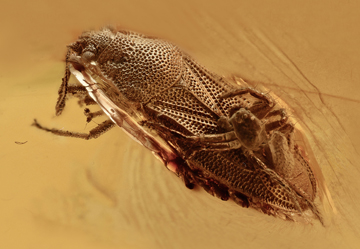Abstract
Clam shrimp (Spinicaudata) are worldwide distributed branchiopod crustaceans specialised in ephemeral freshwater habitats. The Carboniferous is an important period for the early evolution and diversification of clam shrimp. Compared with the rare and geographically confined fossil record of the Devonian, clam shrimp in the Carboniferous have a much wider geographical distribution and higher biodiversity. Over 20 genera of clam shrimp have been recorded in the Carboniferous all over the world, but they are sparse in China. To date, five records of Carboniferous clam shrimp have been reported from China (Pruvost, 1927; Zhang et al., 1976; Wang, 1987; Zheng et al., 1988; Liu & Fan, 1995; Liao et al., 2019). Among them, four species Lioestheria? mathieui Pruvost, 1927, Protomonocarina huixianensis Wang, 1987, Retrofractus lingyuanensis Liu & Fan, 1995, and Pemphilimnadiopsis cheni Liao, Shen & Huang, 2019, are found in the Pennsylvanian Benxi Formation in North China (Pruvost, 1927; Zhang et al., 1976; Wang, 1987; Liu & Fan, 1995; Liao et al., 2019).
References
Hong, Y.C. (1985) New fossil genera and species of Shanxi Formation in Xishan of Taiyuan. Entomotaxonomia, 7 (2), 83–91 [In Chinese with English abstract].
Liao, H.Y., Shen, Y.B., Gao, J. & Huang, D.Y. (2019) Pemphilimnadiopsis cheni sp. nov. (Branchiopoda: Diplostraca: Spinicaudata) from the Upper Carboniferous of East Hebei, China and its biostratigraphic significance. Palaeoentomology, 2 (4), 381–389.
https://doi.org/10.11646/palaeoentomology.2.4.12
Liu, S.W. & Fan, G.Q. (1995) Retrofractus—a new conchostracan genus from “Benxi” Formation in Lingyuan area, Liaoning Province. In: The Editorial Board of the Memoir of Stratigraphy and Paleontology. Chinese Academy of Geological Sciences (Eds). Memoirs of Stratigraphy and Paleontology 12. Geological Press, Beijing, pp. 71–75 [In Chinese].
Pruvost, P. (1927) La faune du terrain houiller de Bruay dans le bassin de Kaiping (Chine). Annales de la Société Géologique du Nord, 53, 171–172.
Shen, S.Z., Zhang, H., Zhang, Y.C., Yuan, D.X., Chen, B., He, W.H., Mu, L., Lin, W., Wang, W.Q., Chen, J., Wu, Q., Cao, C.Q., Wang, Y. & Wang, X.D. (2019) Permian integrative stratigraphy and timescale of China. Science China-Earth Sciences, 62, 154–188.
https://doi.org/10.1007/s11430-017-9228-4
Sun, B.L., Zeng, F.G., Liu, C., Cui, X.Q. & Wang, W. (2014) Constraints on U-Pb dating of detrital zircon of the maximum depositional age for Upper Paleozoic coal-bearing strata in Xishan, Taiyuan and its stratigraphic significance. Acta Geologica Sinica, 88 (2), 185–197 [In Chinese with English abstract].
Wang, C.Y. & Kang, P.Q. (2000) The base of the Permian System in China. Acta Micropalaeontologica Sinica, 17 (4), 378–387 [In Chinese with English abstract].
Wang, D.Y. (1987) Branchiopoda. In: Institute of Geological Science, Henan (Eds). Stratigraphy and Palaeontology of the Carboniferous and early Early Permian in Henan. China Prospect Publishing House, Beijing, pp. 233–234 [In Chinese].
Wang, X.D., Hu, K.Y., Qie, W.K., Sheng, Q.Y., Chen, B., Lin, W., Yao, L., Wang, Q.L., Qi, Y.P. & Chen, J.T. (2019) Carboniferous integrative stratigraphy and time scale of China. Science China-Earth Sciences, 62, 135–153.
https://doi.org/10.1007/s11430-017-9253-7
Wang, Z.H. (1991) Conodonts from Carboniferous-Permian boundary strata in China with comments on the boundary. Acta Palaeontologica Sinica, 30 (1), 6–45 [In Chinese with English abstract].
Wang, Z.H. & Li, R.L. (1984) Discovery of Late Carboniferous conodonts from Shanxi Province and its significance. Acta Palaeontologica Sinica, 23 (2), 196–205 [In Chinese with English abstract].
Wang, Z.H. & Qi, Y.P. (2003) Review of Carboniferous-Permian conodont biostratigraphy in North China. Acta Micropalaeontologica Sinica, 20 (3), 225–243 [In Chinese with English abstract].
Zhang, W.T., Chen, P.J. & Shen, Y.B. (1976) Fossil conchostracans of China. Science Press, Beijing, 325 pp. [In Chinese].
Zheng, Y.Q., Wu, X.L., Li, X.M. & Wu, Q. (1988) Discovery and significances of the Early Carboniferous conchostracans in Shanghang, Fujian. Journal of Stratigraphy, 12 (4), 307–311 [In Chinese].


